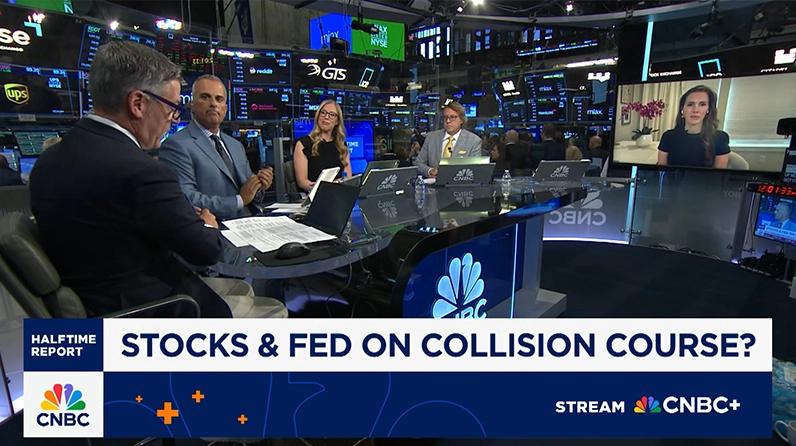

The FOMC seems willing to be patient until it becomes clear through hard data that they need to shift their approach
As expected, the Federal Open Market Committee (“FOMC”) maintained the fed funds target rate at a range of 4.25% to 4.50% and made no additional changes to the runoff of the balance sheet following the announcement in March to slow that pace; the vote was unanimous. Changes to the statement released prior to the press conference included an acknowledgment that “uncertainty about the economic outlook has increased further” and that the Committee “judges that the risk of higher unemployment and higher inflation have risen.” There was also a nod to the recent Q1 GDP print, which came in at -0.3%, with the statement noting that “although swings in net exports have affected the data, recent indicators suggest that economic activity has continued to expand at a solid pace.”
During the press conference, Federal Reserve Chairman Jerome Powell reiterated a similar stance to those shared by Fed officials during the weeks prior to the blackout. He admitted that while the Fed is worried about the potential for higher unemployment and higher prices, it is too soon to act on either based on the divergence between hard and soft data. Powell believes that monetary policy is in a good position and that while the Fed “can move quickly when that’s appropriate”, the bar seemed to be set a bit higher today for a June rate cut. This was reflected in expectations, which declined to less than 25% after today’s announcement and press conference.
Not surprisingly, yields were little changed following the meeting. As for the equity markets, they were lower following the release of the statement; however, the release coincided with a comment from U.S. President Donald J. Trump who indicated that he is unwilling to roll back the commitment to 145% tariffs on Chinese goods. This comes ahead of important meetings in Switzerland between U.S. Treasury Secretary Scott Bessent and U.S. Trade Representative Jamieson Greer and China Vice Premier He Lifeng. The potential for U.S.-China rapprochement is likely to move back to the front burner over the coming weeks, particularly as earnings season wraps and macroeconomic and policy activity drives market activity.
In short, following today’s statements, it is apparent in our view that the FOMC, led by Powell, are willing to be patient until it becomes clear through hard data that they need to shift their approach. The delicate balance between unemployment and inflation is driving this hesitancy as it becomes increasingly difficult to offset employment weakness through monetary stimulus if supply chain dislocations are transmitting to higher prices. Much like companies and consumers, the Fed will need to react to policy changes in real time over the next few months while anchoring to its longer-term goals. With the 90-day delay on tariffs set to expire in early July and multiple tax bills weaving their way through Congress with a target of July 4th for agreement, there is likely to be much more for the Fed to grapple with in the next two meetings.


VIDEO
Shannon Saccocia Featured on CNBC’s Halftime Report

INSIGHTS
CIO Notebook: July CPI In Line as Services Inflation Reaccelerates

MARKET COMMENTARY
Anything But the Doldrums

Accolades
Forbes | SHOOK 2025 Top Next-Gen Advisors Best-in-State

INSIGHTS
CIO Notebook: U.S. Non-Farm Payrolls Light, Putting Fed Cut Back on the Table

INSIGHTS
CIO Notebook: Fed Still on Hold, Timing of Cuts Remains Uncertain

VIDEO
Mid-Year Check-In
REPLAY
Private Wealth Investment Outlook 3Q25
INSIGHTS
Safeguarding and Supporting Loved Ones in Mental Decline
INSIGHTS
The International Moment
INSIGHTS
Sizing Up Cryptocurrency
Accolades
Barron’s Top 100 Women Financial Advisors for 2025
MUNICIPAL BASIS POINTS
All You Can Eat
IMPORTANT INFORMATION:
This material is provided for informational purposes only and nothing herein constitutes investment, legal, accounting or tax advice, or a recommendation to buy, sell or hold a security. This material is general in nature and is not directed to any category of investors and should not be regarded as individualized, a recommendation, investment advice or a suggestion to engage in or refrain from any investment-related course of action. Any views or opinions expressed may not reflect those of the firm as a whole. Neuberger Berman products and services may not be available in all jurisdictions or to all client types. Diversification does not guarantee profit or protect against loss in declining markets. Investing entails risks, including possible loss of principal. Investments in private equity are speculative and involve a higher degree of risk than more traditional investments. Investments in private equity are intended for sophisticated investors only. Unless otherwise indicated, returns shown reflect reinvestment of dividends and distributions. Indexes are unmanaged and are not available for direct investment. Investing entails risks, including possible loss of principal. Past performance is no guarantee of future results.
Portfolio positioning views expressed herein are those of Neuberger Berman’s Private Wealth Investment Group, which may include those of the Neuberger Berman’s Asset Allocation Committee. Asset allocation and positioning views are based on a hypothetical reference portfolio. The Private Wealth Investment Group analyzes market and economic indicators to develop asset allocation strategies. The Private Wealth Investment Group works in partnership with the Office of the CIO. The Private Wealth Investment Group also consults regularly with portfolio managers and investment officers across the firm. The Asset Allocation Committee is comprised of professionals across multiple disciplines, including equity and fixed income strategists and portfolio managers. The Asset Allocation Committee reviews and sets long-term asset allocation models, establishes preferred near-term tactical asset class allocations and, upon request, reviews asset allocations for large, diversified mandates. Asset Allocation Committee members are polled on asset classes and the positional views are representative of an Asset Allocation Committee consensus. The views of the Asset Allocation Committee and the Private Wealth Investment Group may not reflect the views of the firm as a whole and Neuberger Berman advisers and portfolio managers may take contrary positions to the views of the Asset Allocation Committee or the Private Wealth Investment Group. The Asset Allocation Committee and the Private Wealth Investment Group views do not constitute a prediction or projection of future events or future market behavior. Defensive positioning generally means an underweight bias on allocations to risk assets such as equities and alternatives. Positioning views may change over time without notice and actual client positioning may vary significantly. Discussion of yield characteristics or total returns of different asset classes are for illustrative purposes only. Such asset classes, such as equities and fixed income, may have significantly different overall risk-return characteristics which should be consider before investing.
The information in this material may contain projections, market outlooks or other forward-looking statements regarding future events, including economic, asset class and market outlooks or expectations, and is only current as of the date indicated. There is no assurance that such events, outlook and expectations will be achieved, and actual results may be significantly different than that shown here. The duration and characteristics of past market/economic cycles and market behavior, including any bull/bear markets, is no indication of the duration and characteristics of any current or future be market/economic cycles or behavior. Information on historical observations about asset or sub-asset classes is not intended to represent or predict future events. Historical trends do not imply, forecast or guarantee future results. Information is based on current views and market conditions, which will fluctuate and may be superseded by subsequent market events or for other reasons.
Discussions of any specific sectors and companies are for informational purposes only. This material is not intended as a formal research report and should not be relied upon as a basis for making an investment decision. The firm, its employees and advisory accounts may hold positions of any companies discussed. Nothing herein constitutes a recommendation to buy, sell or hold a security. It should not be assumed that any investments in securities, companies, sectors or markets identified and described were or will be profitable. Investment decisions and the appropriateness of this content should be made based on an investor's individual objectives and circumstances and in consultation with his or her advisors.
Neuberger Berman Investment Advisers LLC is a registered investment adviser.
The “Neuberger Berman” name and logo are registered service marks of Neuberger Berman Group LLC.